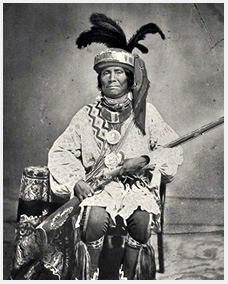
The Seminole Tribe of Florida has a long history in the Greater Tampa Bay area and has maintained their independence and preserved their unique culture and traditions throughout centuries of conflict and struggle.
“So, the Seminoles and their ancestors have been in Florida, for lack of a better word, forever,” said Dr. Andrew Frank,Professor of History at Florida State University, and an ethnohistorian who specializes in the history of the Florida Seminoles and the Native South. “So they trace their ancestry back to Native American migrants—we call them Creeks—from north Florida, Georgia and Alabama. And they also trace their ancestry to the Calusa, the Tocobaga—these Native American groups that predate the arrival of Europeans.”
After 1765, all Indians in Florida were referred to as Seminoles, a word that originated from the Spanish “cimarron” meaning “wild” or “runaway.”
The Seminole Wars
The United States government waged three conflicts against the Seminoles during the 1800s referred to collectively as The Seminole Wars. Dr. Frank explained that each war was part of a larger attempt to exterminate Native Americans everywhere east of the Mississippi River.
“It’s basically an attempt by the United States to erase the indigenous presence in Florida,” he said.
The Seminole Tribe of Florida views it as one long war with no periods of peace in between.
The Second Seminole War took place in what some refer to as ‘Greater Gainesville south,’ said Dr. Frank. “There’s a Tampa component to the first, second and third.”
Fort Brooke, which was located in the southern part of what is now downtown Tampa, was one of numerous forts constructed and garrisoned in Florida as part of major U.S. military operations designed to capture and transport the Seminoles out of Florida. It becomes a holding area for captured Seminoles being forcibly removed west to Oklahoma along the “Trail of Tears,” he said.
The ‘unconquered Seminoles’
The Seminoles ultimately withstood the U.S. assault despite being outgunned and outnumbered, said Dr. Frank.A group of Florida Seminoles were able to avoid removal and escape into the Everglades and join tribal members already residing there. The military did not pursue them. For this reason, descendants of people who lived in the Everglades often call themselves “the unconquered Seminoles,” said Dr. Frank. The Seminole Tribe of Florida, the Miccosukee Tribe of Florida and the Independent Seminoles descend from this small band.
The idea of the Florida Seminoles as a political entity is a modern notion that arose in the 1950s when they organized and became a federally-recognized sovereign tribe in 1957, he said. Today, Tampa is home to one of the Seminole Tribe of Florida’s six reservations. It was established in the late 20th Century.
The Seminole Tribe of Florida have engaged in myriad economic development projects, which includes owning Hard Rock Hotel & Casinos and running one of the biggest cattle operations in the U.S.
Maintaining their unique culture while operating within the mainstream economy has been identified as “the priority for today’s Seminole Tribe of Florida,” according to their stated objectives.
Additional sources:
www.ahtahthiki.com, https://museumoffloridahistory.com/exhibits/previous-exhibits/seminole-people-of-florida/seminole-history/, https://www.semtribe.com/stof/history/introduction, https://libguides.ocls.info/nativeAmericans/tribes, https://www.semtribe.com/stof
Photo of Holatta Micco (Billy Bowlegs), via semtribe.com.
By Colin McCandless.





